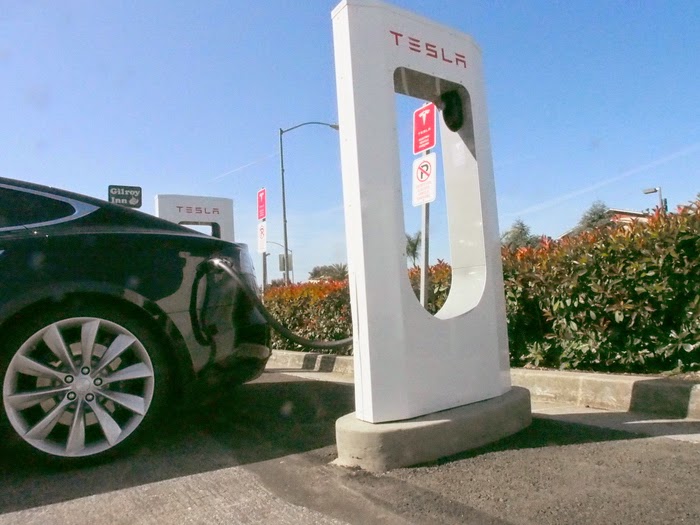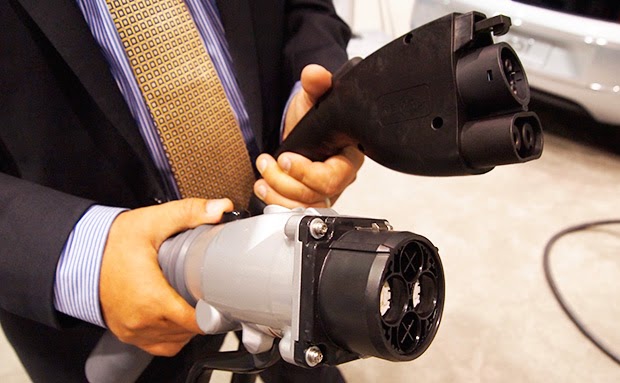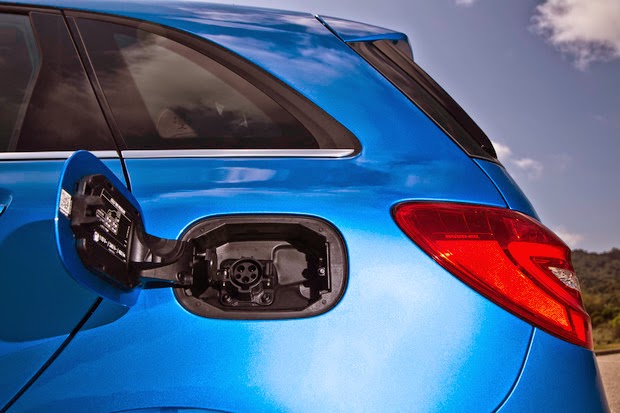The problem is the a) near-uselessness of public level 2 charging, and b) the fragmentation in the market for DC Fast Charging.
When I say “near uselessness of public level 2 charging” I want to be clear – I use public level 2 charging, and think that it’s a huge improvement over no public EV charging. What’s useless about it is that a 6.6 kilowatt charging station provides about 20-25 miles of range per hour of charging. Useless for taking a road trip.
The road trip scenario is where the Tesla Model S and Tesla Supercharger shine. If your road trip happens to coincide with the supercharger network, using those stations gives you 300 miles of range per hour of charging, fast enough for all but the most die-hard of road trippers.
I’m certain the major automakers see the prospect of an all electric $35,000 electric car from Tesla, slated for the 2017 model year, and are very concerned. How will they compete? We don’t know what the major automakers have in store for introductions over the next 3-4 years, but the Tesla Motors roadmap is extremely compelling.
But the big problem is the walled gardens between different camps in DC Fast Charging:
CHAdeMO – a “standard” of sorts, used primarily on the Nissan Leaf, with thousands of deployments around the world, and years of experience in Japan. Over 100,000 compatible electric cars world-wide.
SAE Combo Charging System – a standard from the official automotive industry, supported by the major manufacturers, at least those based in North America or Europe. However, only the Chevy Spark EV and BMW i3 support the standard, and it’s new enough it has seen very little deployment and very few compatible cars.
Tesla Supercharger – the non-standard that’s proprietary to Tesla Motors, and supported only by the Tesla Model S. Over 30,000 compatible electric cars now. Lots faster than the other two systems.
Of the three it’s the Supercharger which does proper road trips. CHAdeMO and CCS are limited to about 50 kilowatts (I think both are spec’d for higher power, but 50kw is the limit of charging stations), meaning an electric car gains about 100 miles per hour of charging. That’s nowhere near as good as the Supercharger system, plus the cars compatible with either CHAdeMO or CCS have a driving range much smaller than the Tesla Model S (80ish miles versus 250ish).
From that standpoint the Supercharger is the preferred solution for fast charging. It’s ultra fast, and the connector/cable combination is designed for humans. CHAdeMO/CCS are not quite fast, and the connector/cable combination is heavy and clunky.
It means the macro-economics of this is a waste of resources. Two full infrastructures for fast charging are being built – CHAdeMO/CCS (because charging station makers are building dual-protocol stations) being installed by various charging station operators – and the Tesla Supercharger network. It would be better for consumers to have one DC Fast Charging standard so that the “Network Effect” would make fast charging that much more valuable to us all.
What’s the solution offered by Elon Musk?
Tesla Motors hasn’t released the details yet, but over the weekend Musk said to reporters in England that Tesla is planning a controversial move – to open the Supercharger design, allowing other automakers to also implement the system. Automakers would have to agree to help fund the Supercharger system, and not charge car owners for its use.
Specifically (from Engadget![]() ):
):
Musk: … The intent of the Supercharger network is not to create a walled garden. Any other manufacturer that’s interested in using them, we’d be happy to accommodate. It’s just that they need to be able to accept the power level of the Superchargers, which is currently 135kW and rising, so any car needs to meet the Supercharger standard. And they’d also need to agree with the business model, which is we don’t charge people on a per-charge basis. They’d need to contribute to the capital costs proportional to their fleet’s usage of the network. So we think that’s pretty fair.
What does this mean?
Over the weekend I saw a factoid saying that the automaker which invented the seatbelt chose to open all the patents and designs for seatbelts, rather than maintain proprietary control. The result was an untold number of lives saved through seatbelts being installed in every car and reducing occupant damage in traffic accidents.
 |
| Leaf’s & Tesla’s both have fast charging But with incompatible systems |
There’s a parallel here with electric car fast charging. The excellent fast charging system, Supercharger, is trapped for use only by the ultra expensive Tesla Model S. Regular people can’t afford a Model S, leaving the Supercharger to be a toything of the ultra rich.
The Supercharger isn’t going to do much good until there’s millions and millions of cars using the system. What Tesla Motors hopes to do is jump-start Supercharger usage into the millions of cars faster than if Tesla were to do it alone.
Opening the Supercharger design is the same strategy as opening the design for seatbelts was. If other automakers take Tesla’s technology offer, and adopt the Supercharger design, then their manufacturing rate adds to Tesla’s, the Supercharger network becomes more widely used.
That should speed up overall electric car adoption because more drivers will be able to enjoy 300 miles of range per hour of charging.
But – this scenario has two major flaws. First, is Supercharger the only way to implement 300 miles of range per hour of charging? Probably not. Second, it assumes a big change of behavior for the other automakers. Past actions by all of them demonstrate they’re unlikely to take Tesla up on the offer of Supercharger technology. A few years ago the automakers had the chance to ratify CHAdeMO as the SAE standard, but purposely chose to not do so, leading to the split between CHAdeMO and SAE CCS systems mentioned above.
Daimler’s research and design chief, Thomas Weber was recently quoted on Autoblog Green![]() saying
saying
“The future [of an electric charging infrastructure] lies in standardization. As with gas stations, we need a charging system for all manufacturers, not least because it reduces the cost of the infrastructure, but it is also more convenient for customers.” He said that while complaining about Tesla Motors refusal to use the standardized fast charging system (CCS). Daimler is an investor in Tesla Motors, for what it’s worth.
With friends like that in the auto industry, I’d say Tesla has an uphill battle ahead of itself to get other automakers on board with the Supercharger system.
The CHAdeMO/CCS form of fast charging is good, but not excellent. The Supercharger system is excellent, but the compatible cars are not affordable for the masses. Widespread Supercharger deployment depends on Tesla Motors becoming a major automaker, which is not a given.
Elon Musk described the motive as being connected to the Tesla Motors mission – to speed up adoption of electric cars and create the society-wide benefits they offer. What he talked about last week is the balancing act between acting for society’s benefit, while satisfying his fiduciary duty to shareholders.
Giving away the Supercharger technology could do that – maybe, or as I said earlier, maybe not.
Instead it might be a chance for Tesla Motors to shame all the other automakers. “Look” Tesla might say in a few years, “not only are we beating you with better technology, we offered it to you and you didn’t take it.”
- Highway design could decrease death and injury risk, if “we” chose smarter designs - March 28, 2015
- GM really did trademark “range anxiety”, only later to abandon that mark - March 25, 2015
- US Government releases new regulations on hydraulic fracturing, that some call “toothless” - March 20, 2015
- Tesla Motors magic pill to solve range anxiety doesn’t quite instill range confidence - March 19, 2015
- Update on Galena IL oil train – 21 cars involved, which were the supposedly safer CP1232 design - March 7, 2015
- Another oil bomb train – why are they shipping crude oil by train? – Symptoms of fossil fuel addiction - March 6, 2015
- Chevron relinquishes fracking in Romania, as part of broader pull-out from Eastern European fracking operations - February 22, 2015
- Answer anti- electric car articles with truth and pride – truth outshines all distortions - February 19, 2015
- Apple taking big risk on developing a car? Please, Apple, don’t go there! - February 16, 2015
- Toyota, Nissan, Honda working on Japanese fuel cell infrastructure for Japanese government - February 12, 2015
















